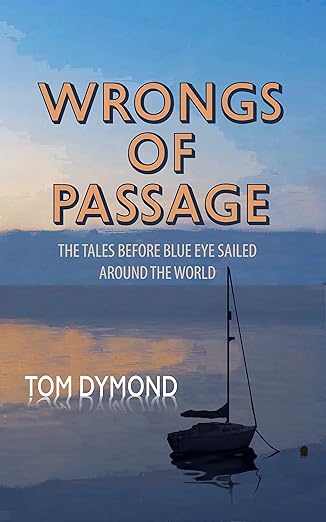
Tom Dymond is a travel writer residing in Bristol, England. Throughout his three-year journey around the globe on a ten-metre boat, he contributed articles to yachting magazines in both the UK and the US. He has since released his inaugural travel series, detailing the 32,000-mile circumnavigation he and his longtime friend, James, embarked upon aboard a small vessel named Blue Eye.
This true narrative highlights the genuine challenges of sailing, camaraderie, and self-discovery. It is immensely entertaining. Beautifully written. Exceptionally structured, this remarkable book will attract both yacht enthusiasts and land lovers alike. It is such an enjoyable read. Tom possesses a captivating writing style that immerses you in the experiences of these two friends. I found it impossible to set down and completed it in a single sitting.
It comes highly recommended. A fantastic book, brimming with grand adventures as well as numerous cherished moments. The humor and personal insights are significant aspects of the book - thus, you do not need to be a sailor to appreciate it. The finest books from the most talented authors are akin to this; they do not strive for effect, but rather are humble and straightforward to read.
While I cannot assess Tom's sailing abilities, I can affirm that he is a skilled author. This humorous prelude features two friends sailing around the world. I have "Hooked on the Horizon" on my reading list after enjoying this. Whether you choose to read this before or after "Hooked on the Horizon," you will discover the artfully narrated backstory of how Blue Eye and her crew united and readied themselves for their circumnavigation.
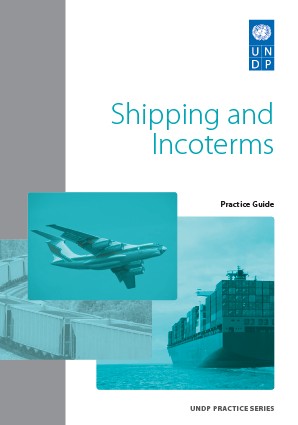
This practice guide is intended for individuals working within UNDP who wish to acquire a comprehensive understanding of suitable shipping arrangements, necessary documentation, and Incoterms. Furthermore, it is pertinent for those engaged in roles that involve significant interaction with procurement or logistics, such as program staff seeking a deeper insight into shipping operations.
The guide encompasses various topics, including the principles of effective shipping arrangements, strategies for risk mitigation, and an overview of options available for enhancing the organization’s logistical activities. It also addresses the capability to plan, execute, and assess a transportation operation that aligns with the value and risk associated with the goods being transported. This guide provides an overview of the various shipping modes to identify the appropriate logistical arrangements for diverse requirements; it also introduces a broad understanding of the necessity for insurance and the types of coverage that are available.
Additionally, the book elucidates the advantages and disadvantages of different Incoterms, their appropriate application, and discusses loss prevention strategies, including measures and actions to minimize or avert loss, as well as effective packing and marking techniques. Customs procedures are thoroughly examined, along with the suitable shipping methods based on several factors such as cost, frequency, reliability, and required speed; it is noteworthy that the authors also clarify the roles of shipping documents, including the Air Waybill and Bill of Lading.

The rapid advancements in technology have fundamentally altered our understanding and approach to measurement. Many instruments now taken for granted were simply unavailable when I began my engineering studies in the 1960s. At that time, a formal course in "Mechanical Measurements" was rare in Mechanical Engineering curricula; learning primarily occurred through hands-on laboratory experience.
Electrical Engineers were comparatively better prepared thanks to a dedicated year of study in "Electrical Measurements." Even when "Mechanical Measurements" was introduced later, the focus was predominantly on instrument descriptions, neglecting a comprehensive examination of underlying principles. As a result, mechanical engineers of that era often lacked a solid foundation in measurement error analysis, regression techniques, and related concepts.
Furthermore, the integrated circuit and digital computer were only beginning to emerge, setting the stage for revolutionary changes. These developments have shifted the focus of measurement from the instruments themselves to the measurement process. Modern approach emphasises the methodology, i.e. how to measure rather than which equipment to use. One strives to makes the most of available budget and resources to ensure that all the measurements are the best that they can be.
For close to two decades, I've been teaching a course originally titled "Measurements in Thermal Science," subsequently renamed "Measurements in Thermal Engineering," yet the course's core emphasis on the measurement process remains constant. Students dedicate roughly a third of the semester to understanding fundamental principles. With this understanding in place, they are well-prepared to tackle the measurement of quantities relevant to mechanical engineering. The course emphasises problem-solving skills, encouraging students to independently research instruments through available digital library resources.

The landscape of cybersecurity literature is vast, filled with titles addressing general principles and highly specialized techniques. However, many fail to connect cybersecurity concepts to specific and vital domains, leaving a significant need for practical application. One area particularly lacking attention is maritime cybersecurity, a critical concern given the industry's significant impact on the global economy.
Kessler and Shepard's "Maritime Cybersecurity: A Guide for Leaders and Managers" effectively addresses this shortfall. Written for executives and management without a technical background, the book immediately grabs the reader's attention with a compelling story of real-world maritime cyberattacks. The subsequent chapters provide a comprehensive examination of the maritime domain, covering a range of topics from the intricate system-of-systems within maritime operations to detailed case studies of cyberattacks on ships and ports.
The authors delve into shipboard networks, communication systems, navigation technologies, and, crucially, effective cyberdefense strategies tailored to the maritime environment. For those new to the nuances of cybersecurity, a dedicated chapter outlines key terminology and potential attack methodologies, many of which are later illustrated with real-world maritime examples.
The engaging narrative and easy-to-understand language ensure the reader remains focused on the high-level concepts rather than becoming lost in technical minutiae. Thoroughly researched and extensively referenced, each chapter providing a wealth of resources for further reading. With decades of combined experience in both education and cybersecurity, Kessler and Shepard have crafted a guide that is both enlightening and highly readable.
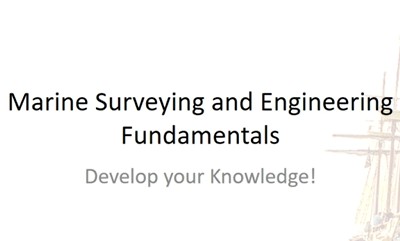
Hello and welcome to “Marine Surveying and Engineering Fundamentals”. What will you get out this course? First of all, of course, a fundamental knowledge and understanding of marine engineering. Apart from that, you will get to know the essential marine surveying responsibilities as this is a must-know prior to commencement of any related activity.
In addition, we addressed many types of technical assessments and surveys to make you have a good coverage and better idea of what you should expect in your work. This course is for professionals who are interested in working in the world of today’s marine engineering, people in need for a good introduction to the topic of marine surveying before pursuing further education in the subject field.
Moreover, it will be very beneficial to the students and engineers who want to improve their knowledge of different parts of the vessel in general. Considering the number of areas covered by the authors of this course, this one is definitely and highly recommended.
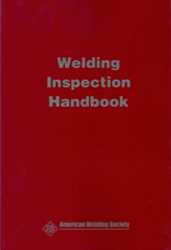
The evaluation of welds and welded assemblies necessitates an understanding of various aspects of welding quality control. This encompasses dimensional inspection, nondestructive examination techniques, welding processes, welding metallurgy, destructive testing, and the qualification of welding procedures and personnel.
Additionally, it involves the review and testing requirements outlined in codes, criteria, and specifications; the acceptance standards to be utilized; as well as a comprehension of drawings, along with welding and nondestructive examination symbols. Familiarity with discontinuities that may arise from different welding processes, and the capability to distinguish between discontinuities and unacceptable defects, is also a crucial component of welding inspection.
This fourth edition of the Welding Inspection Handbook has been compiled by the AWS B1C Welding Inspection Handbook Task Group. Its aim is to furnish a dependable source of valuable reference information. This is especially pertinent for technically trained individuals who may not be directly engaged in inspection but whose roles necessitate an understanding of welding inspection. Furthermore, this book is designed for inspectors requiring a general refresher on the fundamental requirements of weld inspection.
This fourth edition replaces the AWS Welding Inspection Handbook of the same title and incorporates modifications to numerous clauses to enhance clarity, rectify inconsistencies, and reflect current industry practices. Text that is underlined in the clauses and subclauses signifies a modification from the 2000 edition. A vertical line in the margin denotes a revision from the 2000 edition. Additional literature on the topics addressed in each chapter can be located in reputable technical libraries. The various specifications and codes utilized as examples may also be referenced for more comprehensive information.
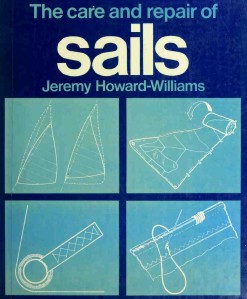
Sails are intricately connected in every aspect to the material from which they are constructed, making it impossible for any book that aims to explore them in detail to overlook the process of sailcloth production and the essential qualities it must possess. The sailmaker invests considerable care and expertise in selecting the cloth for your sail; therefore, it is important to recognize this knowledge when you encounter it, as it is integral to his profession.
Much hinges on his selection, so let us examine some of the factors he must take into account. Sailcloth is typically woven by arranging threads on the loom's beam to create the warp, or lengthwise threads, and then interlacing the thread back and forth over and under the warp to produce what is referred to as the weft.
The resulting weave is compacted by beating the weft, ensuring it lies closely together; the tighter the weave, the greater the cover factor, as the weft causes the warp to crimp. When tension is applied along the warp, the lengthwise threads tend to straighten their crimp and open the weft, which increases the cloth's porosity and diminishes its ability to retain any chemical fillers that may have been incorporated; the individual threads may also slightly untwist and elongate.
However, the stretch is minimal, and no significant deformation of the cloth occurs. Nevertheless, when tension is applied at an angle to the threadline, the small squares created by the weave become distorted into diamond shapes, causing the cloth to elongate in the direction of the tension and narrow across this line.
Consequently, the cloth shifts at right angles to a line of bias tension, resulting in a fold of additional material along this line; the outcome in a sail is increased draft along the tension line and a flattening in the area from which the cloth has been drawn. A quality cloth should not remain permanently deformed after such stress but should return to its original shape once the tension is released.
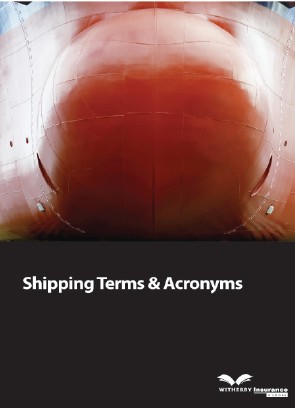
This is a very rare publication by Witherby Insurance, intended to provide the participants of the international maritime shipping industry with the ready reference source for all shipping terminology and acronyms they may encounter when performing their everyday activities.
Needless to repeat how important it is today, and actually always, to have clear knowledge of the terminology. You are kindly invited to get your copy of this guide and have it readily available at all times when doing your job, in order to avoid any potential confusion.
The content has been updated by the authors and is now reflecting all recent happenings within the industry. The material of the booklet is arranged in two major parts, one is the Acronyms from A to Z, and the second is devoted entirely to the shipping terminology.